
Iniidae is a family of river dolphins containing one living genus, Inia, and four extinct genera. The extant genus inhabits the river basins of South America, but the family formerly had a wider presence across the Atlantic Ocean.
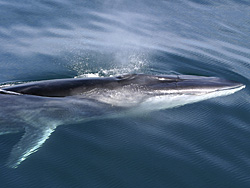
Balaenoptera, from Latin: balaena ('whale') and Ancient Greek: pteron ('fin'), is a genus of Balaenopteridae, and contains eight extant species. Balaenoptera comprises all but one of the extant species in its family.

Hesperornis is a genus of cormorant-like bird that spanned the first half of the Campanian age of the Late Cretaceous period. One of the lesser-known discoveries of the paleontologist O. C. Marsh in the late 19th century Bone Wars, it was an early find in the history of avian paleontology. Locations for Hesperornis fossils include the Late Cretaceous marine limestones from Kansas and the marine shales from Canada. Nine species are recognised, eight of which have been recovered from rocks in North America and one from Russia.
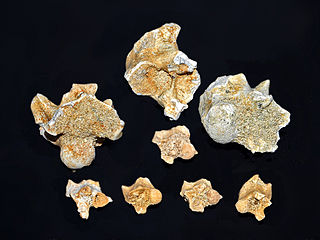
Palaeophis is an extinct genus of marine snake that is the type genus of the extinct snake family Palaeophiidae.

Clausinella fasciata, the banded venus, is a marine bivalve mollusc in the family Veneridae.

Lithophaga, the date mussels, are a genus of medium-sized marine bivalve molluscs in the family Mytilidae. Some of the earliest fossil Lithophaga shells have been found in Mesozoic rocks from the Alps and from Vancouver Island.
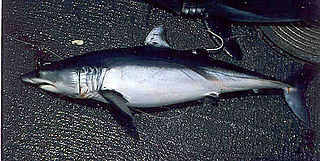
Isurus is a genus of mackerel sharks in the family Lamnidae, commonly known as the mako sharks.

Thalassina is a genus of mud lobsters found in the mangrove swamps of the Indian Ocean and western Pacific Ocean. Its nocturnal burrowing is important for the recycling of nutrients in the mangrove ecosystem, although it is sometimes considered a pest of fish and prawn farms.
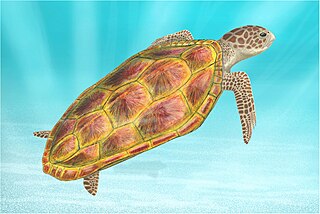
Santanachelys gaffneyi is an extinct species of sea turtle. It is the only species in the genus Santanachelys, which itself is a member of the extinct family Protostegidae. The species was first described from a 20-centimeter long fossil specimen unearthed in 1998 from the Santana Formation of eastern Brazil. From the rock layer from which it was excavated, it was determined that the specimen was from the Early Cretaceous period. It is therefore one of the oldest known sea turtles. It was even recorded as the oldest sea turtle in Encyclopædia Britannica, but a new fossil named Desmatochelyspadillai in 2015 is estimated to be as old as 120 million years.
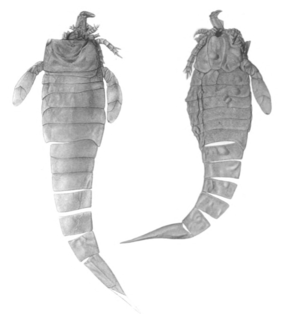
Hughmilleria is a genus of eurypterid, an extinct group of aquatic arthropods. Fossils of Hughmilleria have been discovered in deposits of the Silurian age in China and the United States. Classified as part of the basal family Hughmilleriidae, the genus contains three species, H. shawangunk from the eastern United States, H. socialis from Pittsford, New York, and H. wangi from Hunan, China. The genus is named in honor of the Scottish geologist Hugh Miller.
Hyposaurus is a genus of extinct marine dyrosaurid crocodyliform. Fossils have been found in Paleocene aged rocks of the Iullemmeden Basin in West Africa, Campanian–Maastrichtian Shendi Formation of Sudan and Maastrichtian through Danian strata in New Jersey, Alabama and South Carolina. Isolated teeth comparable to Hyposaurus have also been found in Thanetian strata of Virginia. It was related to Dyrosaurus. The priority of the species H. rogersii has been debated, however there is no sound basis for the recognition of more than one species from North America. The other North American species are therefore considered nomina vanum.

Nannopterygius is an extinct genus of ophthalmosaurid ichthyosaur that lived in the Middle Jurassic to the Early Cretaceous. Fossils are known from England, Russia, and Norway.

Gigantatypus is an extinct late Maastrichtian sea turtle that lived in the southern regions of the Tethys Ocean about 100–120 kilometres (62–75 mi) off the north eastern margins of Cretaceous Africa immediately before the Cretaceous–Paleogene extinction events . Fossil remains of Gigantatypus are so far only represented in sediments from Jordan. Estimated at over 3.5 metres (11 ft) in length, members of this genus reached remarkably large proportions equivalent to that of or possibly even exceeding Archelon Wieland, 1896 , considered as the largest marine turtles to ever roam the oceans of the world. Although Gigantatypus apparently did not survive the K/T boundary, which also was the fate of other gigantic marine turtles such as protostegids, other genera of Cheloniidae, though significantly smaller in size survived the mass extinction and continued on until the present day.
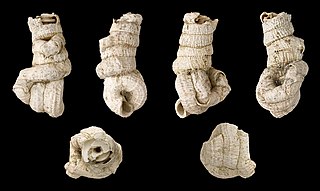
Petaloconchus is a genus of sea snails, marine gastropod mollusks in the family Vermetidae, the worm snails or worm shells.

Tarasiiformes is an extinct order of prehistoric ray-finned fish.
Meherrinia is an extinct genus of inioid river dolphin from the Meherrin River, North Carolina, in the United States. First described in 2012, the dolphin is, in most respects, intermediate in form between the living Amazon river dolphin and the La Plata dolphin, although it is probably more closely related to the former. However, the fossil was discovered in what are believed to be marine deposits, dating from the late Miocene, whereas the Amazon river dolphin is an exclusively freshwater species. Meherrinia therefore may be, as of 2012, the only known marine genus of the family Iniidae. Only one species is known.

Pterotrigonia is an extinct genus of saltwater clams, marine bivalve molluscs in the family Megatrigoniidae. This genus is known in the fossil record from the Jurassic period Tithonian age to the Cretaceous period Maastrichtian age. Species in this genus were facultatively mobile infaunal suspension feeders. The type species of the genus is Pterotrigonia cristata.

Megalochelys is an extinct genus of cryptodiran tortoises that lived from the Miocene to Pleistocene. They are noted for their giant size, which is among the largest of any known testudine, with a maximum carapace length over 2 m (6.5 ft) in M. atlas. During the dry glacial periods it ranged from western India and Pakistan to as far east as Sulawesi and Timor in Indonesia, though the island specimens likely represent distinct species.

Adelophthalmidae is a family of eurypterids, an extinct group of aquatic arthropods. Adelophthalmidae is the only family classified as part of the superfamily Adelophthalmoidea, which in turn is classified within the infraorder Diploperculata in the suborder Eurypterina.
Eodelphinus is an extinct genus of oceanic dolphins belonging to the family Delphinidae.


















